This post contains affiliate links. If you buy something from one of our links we may earn a commission. Thanks
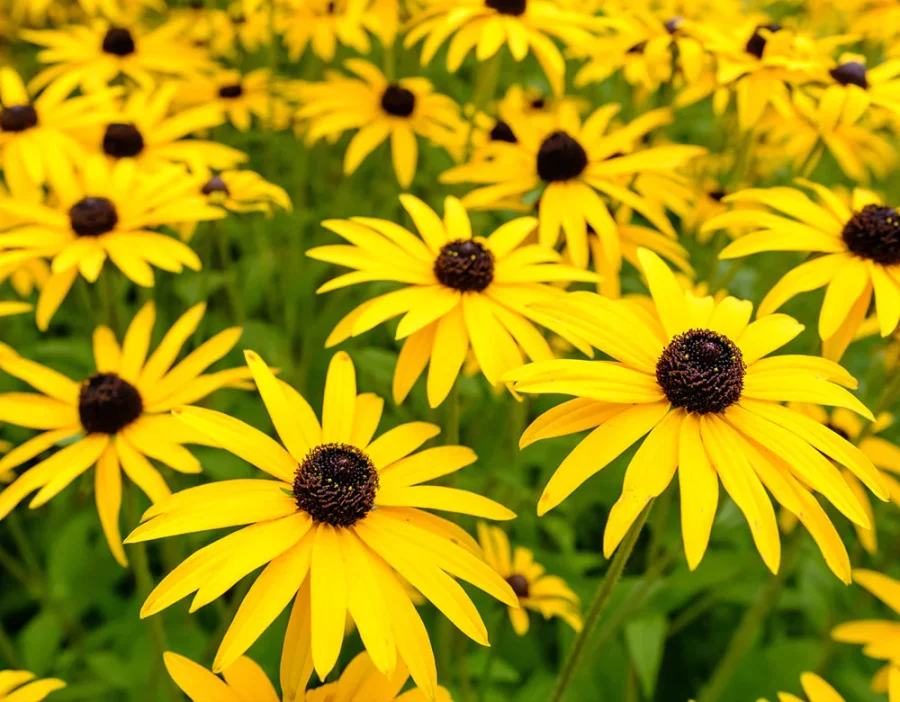
Get your garden blooming with vibrant Black-Eyed Susan plants! Our guide covers everything you need to know about Black-Eyed Susan plant care, from soil to pests.
Black-Eyed Susan care involves full sun exposure, well-draining soil, and regular watering. They thrive in a variety of soil types but prefer soil enriched with organic matter. Water them regularly, but once established, they are drought tolerant. Deadhead spent flowers to encourage more blooms and a tidy appearance.
Are you looking to add a splash of sunshine to your garden with some beautiful Black-Eyed Susan plants?
Well, you’re in luck because today we’re going to be talking all about Black-Eyed Susan plant care.
From the perfect soil and sunlight to keeping those pesky pests at bay, we’ve got you covered.
So, grab your gardening gloves, and let’s dive into the wonderful world of Black-Eyed Susan plant care!
An Introduction To Black-Eyed Susan Plant Care
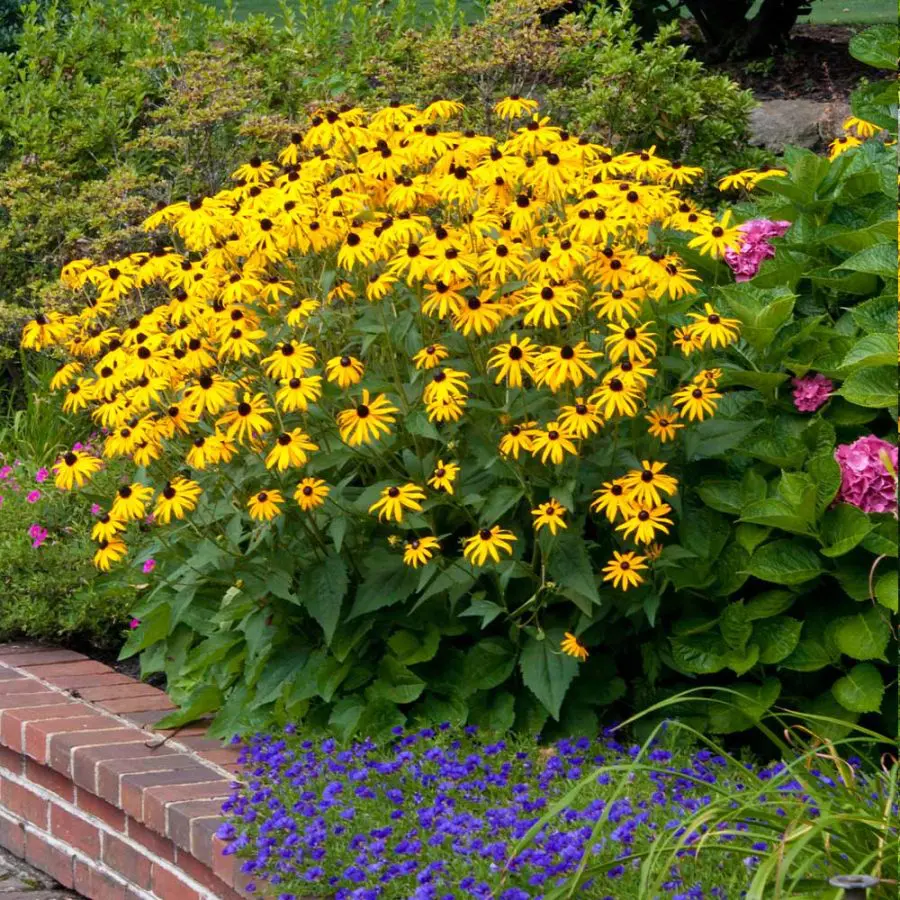
An Overview of the Black-Eyed Susan Plant:
The Black-Eyed Susan plant, also known as Rudbeckia hirta, is a beautiful and hardy perennial that belongs to the sunflower family.
Its yellow-gold petals and black center make it a popular choice for gardens and landscapes and the flower garden..
Don’t confuse this plant with the Black-Eyed Susan vine (Thunbergia alata) which is a tender perennial with similar-looking yellow flowers.
Importance of Plant Care:
Like all plants, the Black-Eyed Susan requires proper care and attention to thrive.
In this blog post, we’ll cover everything you need to know to keep your Black-Eyed Susan healthy and vibrant.
Black-Eyed Susan Plant Care Quick Guide
Mature Width: 18-24 in.
Sunlight: Full-Partial
Growth Rate: Fast
Botanical Name: Rudbeckia fulgida var. sullivantii ‘Goldsturm’
Grows Well In Zones: 4-10 outdoors
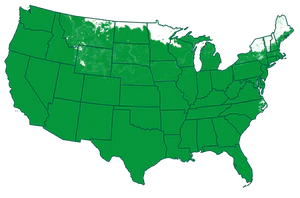
You can buy Black-Eyed Susan plants here
Sunlight Requirements: Black-Eyed Susan plants require full sun, which means they need at least 6 hours of direct sunlight per day.
Soil Requirements: These plants prefer well-draining soil with a pH between 5.5 and 7.5.
Watering Requirements: Black-Eyed Susan plants are drought-tolerant, but they still need regular watering. Water them deeply once a week during dry spells.
Fertilizing Requirements: These plants benefit from a balanced fertilizer applied in early spring and mid-summer.
Pruning and Deadheading: Deadhead spent flowers to encourage more blooms, and prune back any leggy stems to promote bushier growth.
Pests and Diseases: Black-Eyed Susan plants are relatively pest and disease-resistant, but they can still be affected by aphids, slugs, and powdery mildew.
Winter Care: Black-Eyed Susan plants are hardy in most of North America in USDA zones 3-9, but they still need some winter care to survive. Mulch around the base of the plant to protect the roots from freezing temperatures.
The Black-Eyed Susan Plant is considered a short-lived perennial.
It may only last a few winters but it can self-seed prolifically and if you leave some seed heads new plants will come back that way.
Black-Eyed Susan in Pots
Benefits of Growing Black-Eyed Susan in Pots:
Growing Black-Eyed Susan in pots is a great way to add color and interest to your patio or balcony.
Potted plants are also easier to move around and protect from pests and diseases.
Choosing the Right Pot and Soil:
Choose a pot that’s at least 12 inches in diameter and has drainage holes. Use a well-draining potting mix.
Planting Black-Eyed Susan in Pots:
Plant one or two Black-Eyed Susan plants in each pot, making sure the soil is level with the top of the root ball.
Watering and Fertilizing Black-Eyed Susan in Pots:
Water potted Black-Eyed Susan plants regularly, but be careful not to overwater them as this can lead to root rot.
Apply a balanced fertilizer every 4-6 weeks during the growing season.
Maintaining Black-Eyed Susan in Pots:
Deadhead spent flowers regularly and prune back any leggy stems to promote bushier growth.
Check the soil moisture regularly, especially during hot weather, and water as needed.
Pests and Diseases in Potted Black-Eyed Susan:
Potted Black-Eyed Susan plants can still be affected by pests and diseases such as spider mites and powdery mildew.
Inspect your plants regularly and treat any issues promptly. You can use neem oil but be careful to spray in the evening when bees and other beneficial insects are not present.
Black-Eyed Susan Sun or Shade?
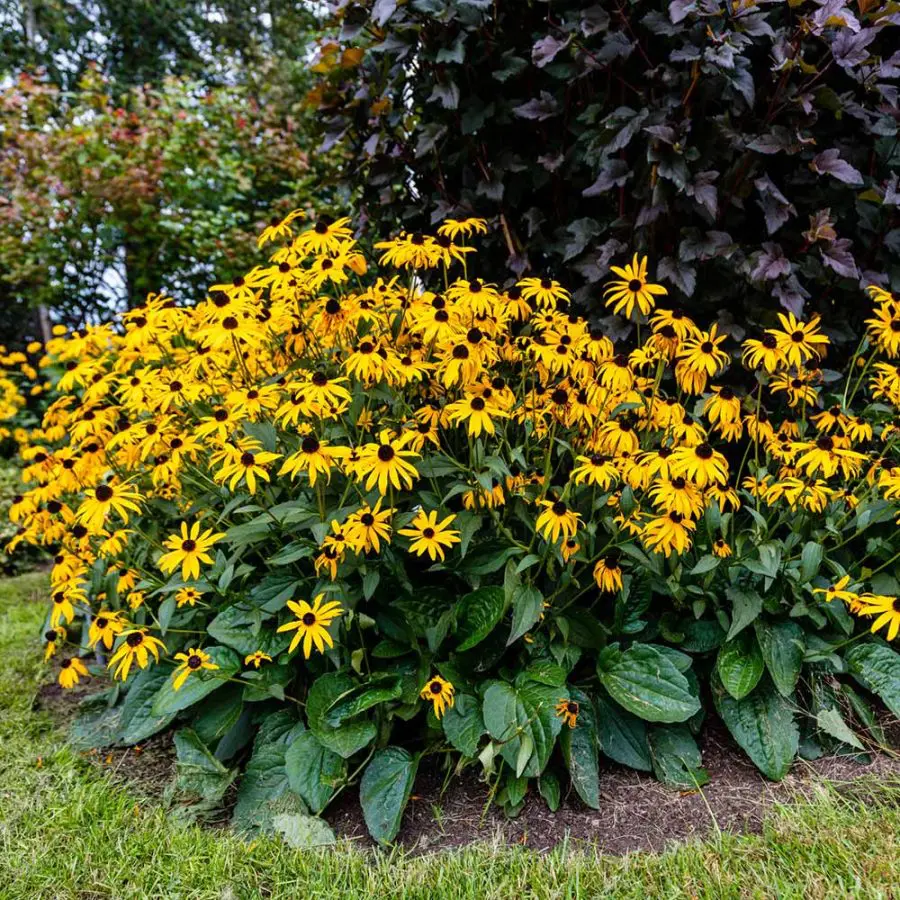
Black-eyed Susans are a popular and vibrant addition to any garden.
These cheerful flowers are known for their golden-yellow petals and dark brown centers that resemble the eye of a bird.
If you’re considering adding Black-eyed Susans to your garden, you may be wondering whether they prefer sun or shade.
The answer is not straightforward, as these hardy plants can adapt to a range of light conditions.
In this section, we’ll explore the ideal sun and shade requirements for Black-eyed Susans, so you can ensure your plants thrive.
Importance of proper sunlight for Black-Eyed Susan plants
Proper sunlight is crucial for the health and growth of Black-Eyed Susans.
While these plants are adaptable and can tolerate a range of light conditions, they do require a certain amount of sun to produce vibrant blooms.
On the other hand, too much shade can result in weak stems and foliage, as well as fewer flowers.
Understanding the sun and shade requirements for Black-Eyed Susans is key to creating a beautiful and thriving garden.
Sunlight Requirements
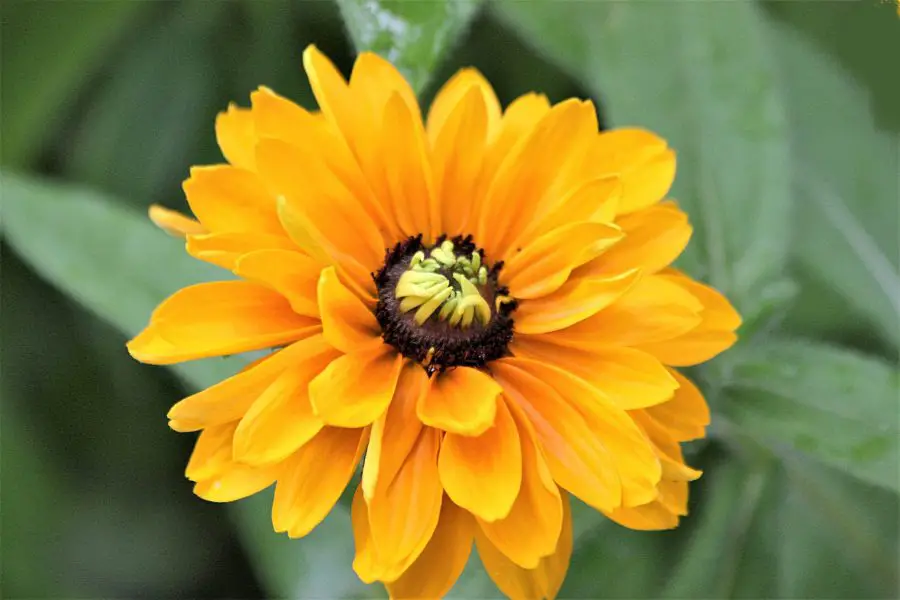
When it comes to sunlight requirements, Black-Eyed Susans are considered sun-loving plants.
These beauties require at least six hours of direct full sunlight per day to thrive.
This means you’ll want to plant them in a spot that receives ample sunlight throughout the day.
They also appreciate being grown in an area with good air circulation,
However, if you live in a particularly hot climate, some afternoon shade can be beneficial to protect the plants from the scorching sun.
In this section, we’ll dive deeper into the sunlight requirements for Black-Eyed Susans, so you can give your plants the best chance of success.
Full Sun vs Partial Shade: Understanding the difference
While Black-Eyed Susans prefer full sun, it’s important to understand the difference between full sun and partial shade.
Full sun means that the plants receive at least six hours of direct sunlight per day.
Partial shade, on the other hand, means that the plants receive less than six hours of direct sunlight per day, but still get plenty of indirect sunlight.
Understanding the difference is key to determining the best spot to plant your Black-Eyed Susans.
The best amount of sunlight for Black-Eyed Susan plants
The ideal amount of sunlight for Black-Eyed Susans is six to eight hours of direct sunlight per day.
This will ensure that your plants produce vibrant blooms and strong stems.
However, if your garden doesn’t receive that much sunlight, don’t worry. Black-Eyed Susans can tolerate some shade and will still grow, albeit with fewer blooms.
How to determine the amount of sunlight in your garden
To determine the amount of sunlight in your garden, you can use a simple method.
Watch your garden throughout the day and note how many hours of direct sunlight each area receives.
You can also use a sunlight calculator or app to help you determine the amount of sunlight in each area of your garden.
Once you have a good idea of how much sunlight each area receives, you can choose the best spot to plant your Black-Eyed Susans.
Planting Tips
If you’re planning to grow Black-Eyed Susans, planting them in the right spot is crucial.
Not only do they require the right amount of sunlight, but they also need the right type of soil and drainage. In this section, we’ll cover some essential planting tips to help your Black-Eyed Susans thrive.
Whether you’re planting them in the ground or in pots, these tips will ensure that your plants get off to a great start. So, let’s get planting!
Finding the right location for Black-Eyed Susan plants
When it comes to planting Black-Eyed Susans, finding the right location is key.
As we discussed earlier, these plants thrive in full sun, so look for an area in your garden that receives at least six hours of direct sunlight per day.
Black-Eyed Susans also prefer well-draining soil, so make sure the area you choose has good drainage.
Avoid planting them in low-lying areas or areas where water tends to collect.
If you are planting black-eyed Susans from seed they will germinate best when the soil temperature is around 70⁰ so plant in late spring once the soil has warmed.
Providing shade in areas with intense sunlight
While Black-Eyed Susans love the sun, intense sunlight can be damaging to their leaves and blooms.
If you live in a desert area with very hot summers, you may need to provide some shade to your Black-Eyed Susans.
You can do this by planting them near taller plants that will provide some shade, or by using a shade cloth or umbrella to protect them during the hottest part of the day.
Avoiding shade in areas with minimal sunlight
On the flip side, if you plant Black-Eyed Susans in an area with minimal sunlight, they may not produce as many blooms.
So, it’s important to avoid planting them in areas with too much shade. Make sure the area you choose receives at least six hours of direct sunlight per day.
If your garden doesn’t receive that much sunlight, consider planting your Black-Eyed Susans in pots that you can move to different areas throughout the day to get the most sun.
Ongoing Maintenance
Now that you’ve found the perfect spot for your Black-Eyed Susans and planted them, it’s time to talk about maintenance.
Don’t worry, Black-Eyed Susans are relatively low-maintenance plants, but there are a few things you can do to ensure they stay healthy and produce lots of beautiful blooms.
In this section, we’ll go over some tips for watering, deadheading, and keeping your Black-Eyed Susans healthy throughout the growing season.
Monitoring sunlight throughout the day
One of the most important things you can do to ensure your Black-Eyed Susans thrive is to monitor the amount of sunlight they receive throughout the day.
This means checking on them at different times and observing the intensity and duration of sunlight in the area where they are planted.
Adjusting sunlight if necessary
If you find that your Black-Eyed Susans are getting too much sun or not enough, there are a few things you can do to adjust the amount of sunlight they receive.
If they are getting too much sun, you can try planting them in an area that gets more shade during the day.
If they are not getting enough sun, you can try pruning nearby trees or plants to allow more sunlight to reach them.
Additional tips for keeping Black-Eyed Susan plants healthy and thriving
In addition to monitoring and adjusting the amount of sunlight your Black-Eyed Susans receive, there are a few other tips you can follow to keep them healthy and thriving.
Make sure they are planted in well-draining soil, as they don’t do well in soggy conditions.
Water them regularly, but don’t overwater, as this can lead to root rot.
Deadhead them regularly to promote new growth and blooms.
Finally, consider fertilizing them once or twice a year with a balanced, slow-release fertilizer to give them the nutrients they need to thrive.
Black-Eyed Susan Water Requirements
Watering your Black-Eyed Susan plants is essential for their growth and overall health.
While it may seem simple, there are a few important things to keep in mind when it comes to watering these vibrant blooms.
In this section, we will go over the water requirements of Black-Eyed Susan plants and how to ensure that they receive the right amount of water to thrive.
Importance of proper watering for Black-Eyed Susan plants
Water is essential for any plant to grow and flourish, and Black-Eyed Susans are no exception.
However, watering them correctly can be a bit tricky. Over-watering can lead to root rot and other issues, while under-watering can cause the plant to wilt and die.
How much water do Black-Eyed Susan plants need?
Understanding Black-Eyed Susan’s Water Needs
Black-Eyed Susans prefer well-draining soil and need consistent moisture, especially during the early stages of growth.
These plants are relatively drought-tolerant once established, but they still need regular watering during dry spells.
In general, aim to provide about an inch of water per week, either through rainfall or manual watering.
Signs of Under-Watering
If your Black-Eyed Susans are under-watered, they will begin to wilt and the leaves may turn yellow or brown.
In severe cases, the plant may even die. If you notice these signs, it’s important to water the plant immediately.
Signs of Over-Watering
Over-watering can be just as damaging as under-watering.
Signs of over-watering include yellowing leaves, moldy or slimy roots, and a foul smell.
If you suspect your Black-Eyed Susan is overwatered, you may need to reduce the watering frequency or improve soil drainage.
When to water Black-Eyed Susan plants
Time of Day
The best time to water Black-Eyed Susan plants is early in the morning or late in the evening, when the sun is not as intense.
Watering during these times can help prevent evaporation and ensure the water reaches the roots where it’s needed.
Frequency
As mentioned earlier, aim to provide about an inch of water per week.
However, this may need to be adjusted depending on factors such as temperature, humidity, and rainfall.
Other Tips for watering Black-Eyed Susan plants
• Avoid getting the leaves wet when watering, as this can lead to fungal disease.
• Mulching around the base of the plant can help retain moisture in the soil.
• Always use room temperature water when watering your Black-Eyed Susans, as cold water can shock the roots.
By following these watering tips, you can keep your Black-Eyed Susan plants healthy and thriving throughout the growing season.
Understanding soil moisture requirements:
Black-Eyed Susan plants thrive in well-draining soil with good levels of organic matter with moderate moisture.
Soil that retains too much moisture can lead to root rot and other diseases, while soil that is too dry can cause stunted growth and wilting.
Before planting, test your soil to determine its moisture content and make necessary adjustments to ensure proper drainage.
Avoiding overwatering:
While Black-Eyed Susan plants require adequate moisture, it’s important not to overwater them.
Too much water can cause the roots to rot and the plant to die. To avoid overwatering, make sure the soil has dried out between watering sessions.
A good rule of thumb is to water the plant deeply once a week, rather than giving it small amounts of water frequently.
Preventing underwatering:
On the other hand, underwatering can also be detrimental to Black-Eyed Susan plants.
When the soil is too dry, the plant will wilt and may even die. To prevent underwatering, check the soil regularly and water the plant when the top inch of soil is dry.
It’s better to water deeply and less frequently than to give the plant small amounts of water frequently.
Additionally, adding a layer of mulch around the plant can help to retain moisture in the soil.
Water Maintenance
Keeping up with proper maintenance is essential for the health and longevity of your Black-Eyed Susan plants.
With a little bit of effort and care, your plants can thrive and produce beautiful blooms year after year. In this section, we will discuss the important steps you can take to keep your Black-Eyed Susans healthy and vibrant.
From monitoring soil moisture to pruning and fertilizing, we’ll cover everything you need to know to maintain your plants and ensure their success. So let’s dive in!
Monitoring soil moisture levels
To keep Black-Eyed Susan plants healthy and thriving, it’s important to monitor soil moisture levels regularly.
These perennial plants like growing in moist soil but avoid soggy soil. This means checking the soil regularly to make sure it’s neither too wet nor too dry.
Adjusting the watering frequency and amounts if necessary
If the soil is too wet or too dry, it’s important to adjust your watering frequency and amounts accordingly.
If the soil is too wet, cut back on watering and allow the soil to dry out a bit before watering again.
If the soil is too dry, increase watering frequency and make sure to water deeply to encourage deep root growth.
Additional tips for keeping Black-Eyed Susan plants healthy and thriving
Other tips for maintaining healthy Black-Eyed Susan plants include providing adequate drainage, mulching to retain moisture, and avoiding overhead watering to prevent leaf diseases.
Additionally, consider using a rain gauge to track rainfall and supplementing with watering if necessary during periods of drought.
When Do Black-Eyed Susans Bloom?
Black-Eyed Susans are a beautiful and popular wildflower that many gardeners love to grow in their yards.
One of the most exciting things about these plants is when they start to bloom. With their bright yellow petals and distinctive dark centers, Black-Eyed Susans are sure to add a pop of color to any garden.
But when exactly do these flowers bloom?
In this article, we’ll dive into the details of Black-Eyed Susan blooming and give you all the information you need to keep your garden looking beautiful all season long.
Blooming Overview
Black-Eyed Susan plants are known for their bright, cheerful blooms that add a pop of color to any garden or landscape.
These hardy perennials are easy to grow and care for, making them a popular choice for both novice and experienced gardeners alike.
Importance of understanding Black-Eyed Susan bloom time
Understanding when Black-Eyed Susan plants bloom is important for several reasons.
It allows gardeners to plan their garden and landscaping design, ensures that the plants are receiving the appropriate care at the right time, and helps to maximize the beauty and longevity of the blooms.
In this section, we will explore when Black-Eyed Susan plants typically bloom and what factors can influence their bloom time.
Bloom Time
Black-Eyed Susans are a popular choice for gardens and landscapes due to their vibrant yellow and gold blooms that add a pop of color to any space.
However, to enjoy their beautiful blooms, it’s essential to know when they typically flower.
Black-Eyed Susans are known for their long blooming period, which can last from mid-summer to early fall.
In this section, we’ll go over the bloom time of Black-Eyed Susans in more detail, so you’ll know exactly when to expect those beautiful flowers.
Typical bloom time for Black-Eyed Susan plants:
Black-Eyed Susans are known for their vibrant yellow-orange petals and dark centers.
These hardy plants are considered late summer bloomers, typically showing off their colorful flowers from mid-July to early September.
Factors that can affect bloom time:
While Black-Eyed Susans typically bloom during a specific time period, various factors can influence their bloom time.
One significant factor is the location and climate of your garden.
Cooler climates can cause Black-Eyed Susans to bloom later in the season, while warmer climates may cause them to bloom earlier.
Other factors that can impact bloom time:
Other factors that can impact Black-Eyed Susan’s bloom time include the plant’s overall health, the amount of sunlight it receives, and the amount of water it gets.
Healthy and well-nourished plants are more likely to bloom on schedule, while plants that are stressed or not receiving adequate care may bloom later or not at all.
Additionally, providing the right amount of sunlight and water can help ensure that Black-Eyed Susans bloom when they should.
Planting Tips
If you’re looking to add Black-Eyed Susan plants to your garden, it’s important to know the best planting tips to ensure they thrive.
In this section, we’ll cover some key planting tips that will help you get started.
From soil preparation to spacing and depth, these tips will give you the information you need to plant your Black-Eyed Susans successfully.
So, let’s get started!
Best time to plant Black-Eyed Susan seeds or transplants
To ensure that your Black-Eyed Susan plants have enough time to establish themselves before blooming, it’s important to plant them at the right time.
For seeds, it’s best to plant them in early spring, around the time of the last frost.
Transplants can be planted once the danger of frost has passed and the soil has warmed up a bit.
Understanding the planting timeline for Black-Eyed Susan plants
Black-Eyed Susan plants take around 60 to 90 days to bloom after they’ve been planted, depending on the variety.
This means that if you want them to bloom in mid-summer, you should plant them in early to mid-spring.
Providing the right growing conditions for optimal bloom time
In addition to planting at the right time, it’s important to provide the right growing conditions to ensure optimal bloom time.
This includes providing full sun, well-drained soil, and adequate water. You can also fertilize your plants to promote healthy growth and blooming.
With the right care, you can enjoy the beautiful blooms of your Black-Eyed Susan plants for many weeks.
Bloom Maintenance
Hey there! So you want to learn how to take care of your Black-Eyed Susan plants to ensure they bloom at the right time?
You’ve come to the right place! In this section, we’ll discuss some maintenance tips that will help keep your plants healthy and happy, so they bloom when you want them to.
From deadheading to fertilizing, we’ve got you covered. So, let’s get started!
Monitoring plant growth and bloom time:
Once you have planted your Black-Eyed Susan plants, it’s important to keep an eye on their growth and bloom time.
This will help you determine if they are thriving or if any adjustments need to be made to their growing conditions.
You can do this by observing the plants regularly and keeping a record of when they begin to bloom.
Adjusting planting timelines if necessary:
If you find that your Black-Eyed Susan plants are not blooming when you had hoped, you may need to adjust your planting timeline.
For example, if you planted your seeds or transplants too late in the season, they may not have enough time to fully mature and bloom.
In this case, you may want to consider planting earlier next year.
Additional tips for keeping Black-Eyed Susan plants healthy and thriving:
In addition to monitoring plant growth and adjusting planting timelines, there are other things you can do to ensure that your Black-Eyed Susan plants are healthy and blooming to their fullest potential.
This includes providing adequate sunlight, watering appropriately, fertilizing as needed, and keeping an eye out for any pests or diseases that may be affecting your plants.
With these tips in mind, you can help your Black-Eyed Susan plants thrive and enjoy their beautiful blooms throughout the growing season.
How to Deadhead Black-Eyed Susans
Hey there! If you’re a fan of Black-Eyed Susans, then you know just how important it is to keep them looking their best throughout the growing season.
One essential task for keeping these stunning flowers looking healthy and vibrant is deadheading.
Deadheading is the process of removing spent blooms from a plant to encourage new growth and extend the blooming season.
In this article, we’ll walk you through the simple steps for deadheading your Black-Eyed Susans so that you can keep them looking their best all season long.
Introduction To Deadheading
Black-Eyed Susan plants are popular garden perennials known for their cheerful, yellow blooms that attract pollinators.
One important aspect of caring for these plants is deadheading, which is the process of removing spent flowers.
Deadheading not only improves the appearance of the plant but also encourages continued blooming and prevents seed formation.
Deadheading Basics
What is deadheading?
Deadheading is the process of removing flowers that have finished blooming or have begun to wilt.
By removing these spent flowers, the plant can redirect its energy into producing new blooms.
How to identify spent Black-Eyed Susan flowers
Spent Black-Eyed Susan flowers can be identified by their withered or browned petals. In contrast, fresh blooms have bright yellow petals.
Tools needed for deadheading
Deadheading can be done by hand or with small pruning shears. Be sure to sanitize the tools before use to prevent the spread of disease.
Deadheading Tips
When to deadhead Black-Eyed Susan plants
Deadheading should be done regularly throughout the blooming season, typically from early summer to fall.
This will encourage the plant to produce more blooms.
Proper technique for deadheading
To deadhead, follow the stem down to the base of the spent flower and cut it off.
If the stem has multiple spent flowers, remove all of them. Be sure to make a clean cut without damaging the plant.
Avoiding damage to the plant
When deadheading, avoid damaging the healthy foliage and stem of the plant.
Be gentle when handling the flowers and use caution when using pruning shears.
Deadheading Maintenance
Removing dead flowers regularly
It’s important to remove dead flowers regularly to prevent seed formation and to encourage the plant to continue producing new blooms.
This also helps to keep the plant looking tidy.
Pruning plants for continued blooming
Pruning the plant can encourage continued blooming. Cut back the entire plant by one-third in midsummer to promote more flowers.
Additional tips for keeping Black-Eyed Susan plants healthy and thriving
In addition to deadheading, Black-Eyed Susan plants require regular watering, fertilization, and pest control to stay healthy.
Be sure to provide the right growing conditions and care to keep your plants thriving.
Black-Eyed Susan Colors
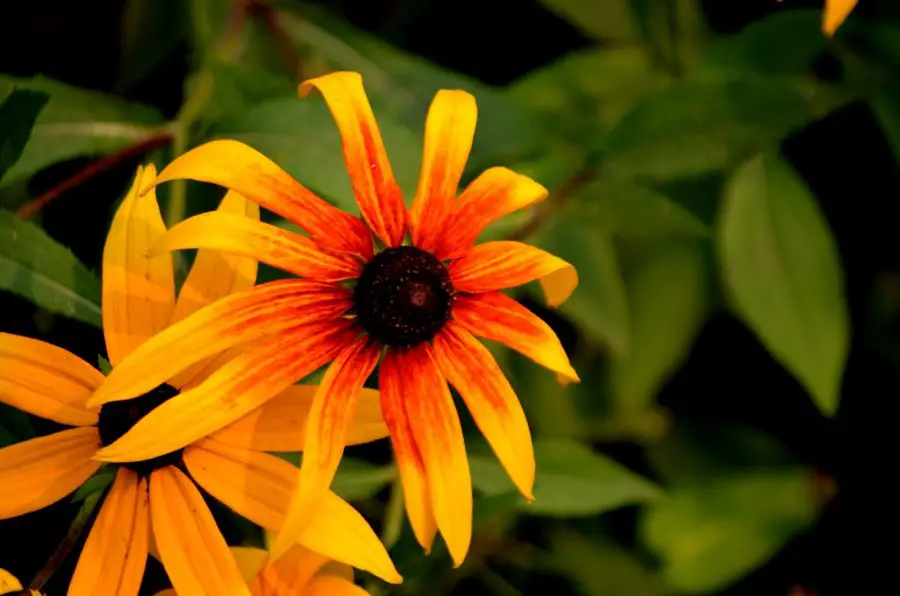
Hey there! Black-Eyed Susans are beloved for their bright, cheerful appearance and their ability to attract pollinators to the garden.
While their name might suggest a specific color, these popular flowers actually come in a variety of hues.
There are many varieties of black-eyed susan. In this guide, we’ll take a closer look at the different Black-Eyed Susan colors you might encounter, as well as some tips for incorporating them into your garden.
So, if you’re a fan of these beautiful blooms, keep reading!
The wide range of Black-Eyed Susan colors
Black-Eyed Susan plants can range in color from yellow to gold, orange, red, and even bi-color and other unique combinations.
Color Variations
The classic yellow Black-Eyed Susan
The most commonly seen Black-Eyed Susan color is the bright yellow flower with a dark brown or black center.
This classic variety is often seen in wildflower meadows and is a popular choice for attracting pollinators.
Gold and orange variations
There are also Black-Eyed Susan plants that feature gold and orange tones. These varieties can add warmth and depth to garden beds and complement other warm-colored plants.
Black-Eyed Susan and other unique varieties
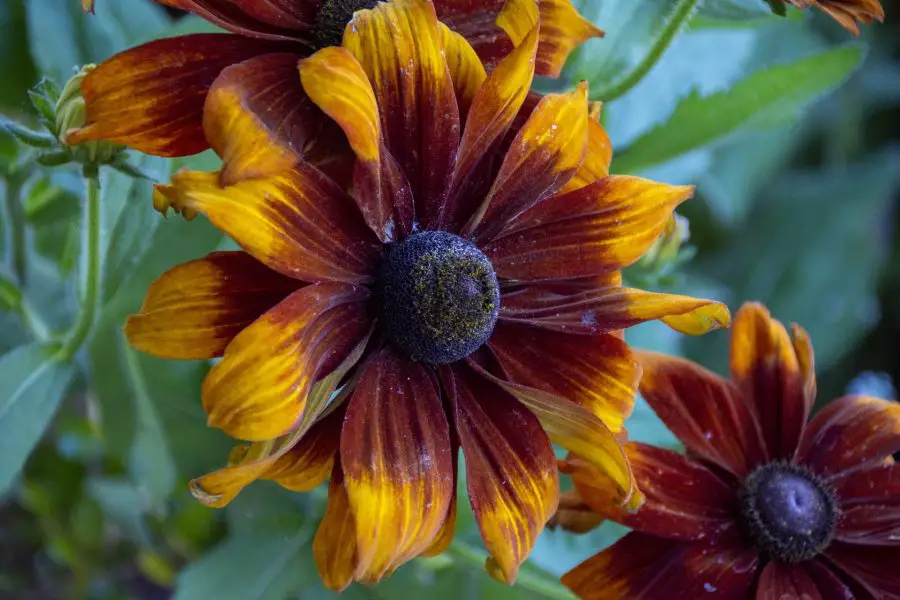
Some Black-Eyed Susan plants have bi-color blooms, with petals in multiple colors, and other unique variations such as the “Irish Eyes” variety, which features green centers instead of the traditional dark brown or black.
Planting Tips
Choosing the right color for your garden
When selecting Black-Eyed Susan plants for your garden, consider the color scheme of your existing plants and choose a color that will complement or contrast them.
Complimentary color combinations for Black-Eyed Susan plants
Black-Eyed Susan plants can be paired with other warm-colored flowers such as purple coneflowers, coreopsis, and asters for a beautiful and cohesive garden design.
Black-Eyed Susan FAQs
Black-Eyed Susan, with its vibrant yellow blossoms, can brighten any garden space, embodying the warmth and cheer of summer days.
This perennial plant is known for its ease of care and ability to attract pollinators like butterflies.
While it’s a hardy plant, understanding its basic care requirements can ensure a burst of color in your garden year after year.
Below are some common questions regarding the nurturing of Black-Eyed Susan:
Q. How much sunlight does Black-Eyed Susan require?
A. Black-Eyed Susan plants thrive in full sun, so they should receive at least 6 to 8 hours of sunlight daily.
Q. When and how often should I water my Black-Eyed Susan plants?
A. Water them regularly, especially during dry spells, until they are established. Once established, they are quite drought-tolerant but prefer a good soak every now and then.
Q. How do I promote more blooms on my Black-Eyed Susan plants?
A. Deadheading, or removing spent flowers, encourages more blooms. Regular deadheading keeps the plant looking tidy and encourages continuous flowering.
Q. Is it necessary to fertilize Black-Eyed Susan plants?
A. While not necessary, a light application of a balanced, slow-release fertilizer in spring can promote vigorous growth and flowering. However, they will grow in poor soil without any fertilization.
Black-Eyed Susan Plant Care Conclusion
And that’s a wrap, my green-thumbed friends!
We hope this guide to Black-Eyed Susan plant care has given you all the tools and tips you need to keep your plants thriving and blooming beautifully.
Remember, Black-Eyed Susan plants are hardy and resilient, but a little bit of care and attention can go a long way in keeping them healthy and happy.
So, keep on nurturing those lovely plants, and enjoy the colorful bursts of sunshine they bring to your garden. Happy gardening!
Recap of Plant Care:
Proper care is essential for the health and vitality of Black-Eyed Susan plants.
Make sure to provide them with plenty of sun, well-draining soil, and regular watering and fertilizing.
Final Thoughts:
Black-Eyed Susan plants are a beautiful addition to any garden or patio. With a little care and attention, you can enjoy their vibrant blooms year after year.
You can buy Black-Eyed Susan plants here
Get more backyard gardening ideas











